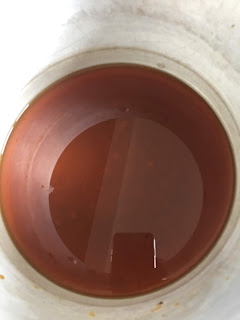After cleaning, peeling and chopping they looked like this.
Next it was time to consult Jenny Deans book ‘Wild Colour’.
The 600gms roots were brought to a simmer for 30 minutes.
Meanwhile I prepared fabric. Animal fibres give the best results and although fabric does not require a mordant I chose to mordant my silk habotai and noil with Alum and Cream of Tartar. A piece of 50/50 silk wool mix was not mordanted.
The wetted fabric was dipped in the dye pots allowing plenty of room for movement of the fabric to ensure an even take up of the dye. The 1st extraction was unfortunately left unattended for enough time to boil which affects the colour changing from a bright yellow to a not unattractive mustard shade. For the second extraction I left the fabric to steep for 8 hours.
This photograph shows the range of colours I achieved on silk habotai and silk georgette & net, the 4th example is the wool/silk mix. I made two extractions the colour diminishing with each one. Interesting I was able to regain the brightness of yellow with the second extraction.
The top two were dyed in an extraction from the leaves which were very small. I expected green but again I think they were heated too much. They are, however, a pleasing coffee colour.
Using iron as a post modifier produced the bottom two olive coloured samples.
This photograph shows the results on silk noil. Similar comment as above. What an amazing set of colour variation. The one difference here was the piece that I had in my stash that had been previously mordanted in Titanium Oxide, third down, which gave a much deeper brighter yellow. For those who have used Titanium Oxide as a mordant you will know this effect. Again the top two are examples of rhubarb leaves dye but this time I dipped the second one in vinegar.
This shows the use of iron as a post modifier on three different samples of silk noil.
Now the samples are collated I know the vat isn’t exhausted yet so I will continue to use it until there is no useable colour left.
I also post dyed some scarves and gave them a new lease of life. Top is a silk noil scarf and below a crepe de chine scarf both have been warmed up after their dye in rhubarb root.
As a postscript here are the cotton samples I dyed in the rhubarb root. Various types of weave and thickness but all with a pleasant milking coffee finish. The top flowery piece was a surprise.
If you have found me and are not aware of my Facebook and Instagram pages do pay me a visit for more regular posts.
Instagram. @inspired_textiles
Facebook Inspired Textiles
Thanks for dropping by, it would be great if you left a comment or subscribed.
Stay safe



















